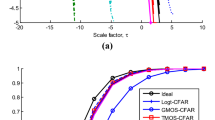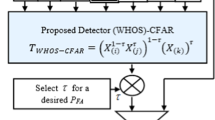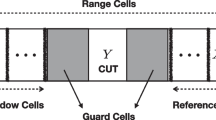Abstract
Recent investigations have validated the Pareto class of models for radar backscattering from the sea surface for X-band maritime surveillance radar. As such, there has been much interest in the derivation of sliding window detectors, for operation in such clutter, with the constant false alarm rate property. A general expression is derived, allowing the determination of the probability of false alarm for such detectors, based upon a recently introduced invariant statistic. For a specific example of its application, a trimmed geometric mean order statistic constant false alarm rate detector is developed and compared with some recently derived detectors. It will be shown that this new detector can be designed to not only manage interference in the clutter range profile but can be very effective at managing range spread targets.







Similar content being viewed by others
Notes
This corrects a typesetting error in the Pfa reported in [29].
References
Finn, H.M., Johnson, R.S.: Adaptive detection model with threshold control as a function of spatially sampled clutter-level estimates. RCA Rev. 29, 414–464 (1968)
Nitzberg, R.: Low-loss almost constant false-alarm rate processors. In: IEEE Transactions on Aerospace and Electronic Systems, AES-15, pp. 719–723, (1979)
Gregers Hanson, V., Sawyers, J. H.: Detectability loss due to greatest of selection in a cell-averaging CFAR. In: IEEE Transactions on Aerospace and Electronic Systems, AES-16, pp. 115–118, (1980)
Weiss, M.: Analysis of some modified cell-averaging CFAR processers in multiple-target situations. In: IEEE Transactions on Aerospace and Electronic Systems, AES-18, pp. 102–114, (1982)
Gandhi, P.P., Kassam, S.A.: Analysis of CFAR processors in nonhomogeneous background. IEEE Trans. Aerosp. Electron. Syst. 24, 427–445 (1988)
Minkler, G., Minkler, J.: CFAR: The Principles of Automatic Radar Detection in Clutter. Magellan, Baltimore (1990)
Mezache, A., Soltani, F.: Threshold optimization of decentralized CFAR detection in weibull clutter using genetic algorithms. Signal, Image and Video Process. 2, 1–7 (2008)
Messali, Z., Soltani, F., Sahmoudi, M.: Robust radar detection of CA, GO and SO CFAR in pearson measurements based on a non-linear compression procedure for clutter reduction. Signal, Image and Video Process. 2, 169–176 (2008)
Abdou, L., Soltani, F.: OS-CFAR and CMLD threshold optimization in distributed systems using evolutionary strategies. Signal, Image and Video Process. 2, 155–167 (2008)
Tabet, L., Soltani, F.: A generalized switching CFAR processor based on test cell statistics. Signal, Image and Video Process. 3, 265–273 (2009)
Alioua, C., Soltani, F.: On the modelling of uncertainty in radar CFAR detection. Signal, Image and Video Process. 4, 381–388 (2010)
Meziani, H.A., Soltani, F.: Optimum second threshold for the CFAR binary integrator in Pearson-distributed clutter. Signal, Image and Video Process. 6, 223–230 (2012)
Zhang, R-l, Sheng, W.-X., Ma, X.-F., Han, Y.-B.: Clutter map CFAR detector based on maximal resolution cell. Signal, Image and Video Process. 9, 1151–1162 (2015)
Weinberg, G.V.: Radar Detection Theory of Sliding Window Processes. CRC Press, Florida (2017)
Conte, E., D eMaio, A., Ricci, G.: Recursive estimation of the covariance matrix of a compound-Gaussian process and its application to adaptive CFAR detection. IEEE Trans. Signal Process. 50, 1908–1915 (2002)
Pascal, F., Chitour, Y., Ovarlez, J.-P., Forster, P., Larzabal, P.: Covariance structure maximum-likelihood estimates in compound Gaussian noise: existence and algorithm analysis. IEEE Trans. Signal Process. 56, 34–48 (2008)
Aubry, A., De Maio, A., Pallotta, L., Farina, A.: Radar detection of distributed targets in homogeneous interference whose inverse covariance structure is defined via unitary invariant functions. IEEE Trans. Signal Process. 61, 4949–4961 (2013)
De Maio, A., Orlando, D.: An invariant approach to adaptive radar detection under covariance persymmetry. IEEE Trans. Signal Process. 63, 1297–1309 (2015)
Balleri, A., Nehorai, A., Wang, J.: Maximum likelihood estimation for compound-Gaussian clutter with inverse-gamma texture. IEEE Trans. Aerosp. Electron. Syst. 43, 775–779 (2007)
Farshchian, M., Posner, F. L.: The Pareto distribution for low grazing angle and high resolution X-band sea clutter. In: IEEE Radar Conference Proceedings, pp. 789–793, (2010)
Weinberg, G.V.: Assessing Pareto fit to high resolution high grazing angle sea clutter. IET Electron. Lett. 47, 516–517 (2011)
Weinberg, G.V.: Constant false alarm rate detectors for pareto clutter models. IET Radar, Sonar and Navig. 7, 153–163 (2013)
Weinberg, G.V.: Examination of classical detection schemes for targets in Pareto distributed clutter: do classical CFAR detectors exist, as in the gaussian case? Multidimens. Syst. Signal Process. 26, 599–617 (2015)
Sahed, M., Mezache, A.: Analysis of CFAR detection with multiple pulses transmission case in Pareto distributed clutter. In: 4th International Conference on Electrical Engineering (ICEE), pp. 1–6, (2015)
Weinberg, G.V., Alexopoulos, A.: Analysis of a dual order statistic constant false alarm rate detector. IEEE Trans. Aerosp. Electron. Syst. 52, 2567–2574 (2016)
Mehanaoui, A., Laroussi, T., Attalah, M. A., Aouane, A.: An EVI-ASD-CFAR processor in a Pareto background and multiple target situations. In: 7th International Conference on Sciences of Electronics, Technologies of Information and Telecommunications (SETIT), pp. 320–325, (2016)
Chalabi, I., Mezache, A., Soltani, F., Khaldi, F.: CFAR detectors for MIMO radars in a Pareto background seminar on detection systems architectures and technologies (DAT), pp. 1–6, (2017)
Weinberg, G.V., Glenny, V.G.: Enhancing Goldstein’s Log-t detector in Pareto-distributed clutter. IEEE Trans. Aerosp. Electron. Syst. 53, 1035–1044 (2017)
Weinberg, G.V.: On the construction of CFAR decision rules via transformations. IEEE Trans. Geosci. Remote Sens. 55, 1140–1146 (2017)
Weinberg, G.V.: An invariant sliding window detection process. IEEE Signal Process. Lett. 24, 1093–1097 (2017)
Acknowledgements
The two reviewers are thanked for their suggestions which improved the manuscript considerably.
Author information
Authors and Affiliations
Corresponding author
Rights and permissions
About this article
Cite this article
Weinberg, G.V. Trimmed geometric mean order statistic CFAR detector for Pareto distributed clutter. SIViP 12, 651–657 (2018). https://doi.org/10.1007/s11760-017-1204-6
Received:
Revised:
Accepted:
Published:
Issue Date:
DOI: https://doi.org/10.1007/s11760-017-1204-6




